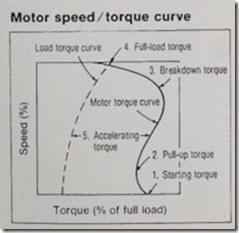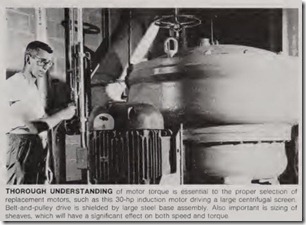A motor has many torques
A BASIC UNDERSTANDING of torque and related terminology is essential to the proper selection and application of motors. This is impor tant not only for new motors, but also when selecting energy-efficient motors for replacement purposes. Most au thoriti es agree that the electrical man’s knowledge of motor application must be broadened as newer designs replace existing motors. In the past, when a motor failed, it was repaired or a duplicate was ordered. Today, and in the future, the newer, energy-efficient motor will be selected.
Torque can be compared to “force.”
The term “force” is commonly used when describing linear motion. Torque describes rotary motion. Actually, torque is the product of force (lbs) and radius (ft) and is expressed in ft-lbs (or in.-oz). In other words, torque is a twisting force. Torque is a measure of the rotational force that a motor canproduce.
A typical ac motor has many differ ent kinds of torque. As noted on the accompanying motor-torque curve, the speed of the motor has a significant effect on its torque. The basic formula for horsepower (HP) shows the inter relationship of torque (T) and speed (rpm):
(The value “5250” is a constant used
when torque is expressed in ft-lbs.)
Starting torque, which is also called “locked-rotor” torque or “break-away” torque, is the torque developed at the moment the motor is started. (See point No. 1 in diagram.)
Pull-up torque is sometimes called minimum torque (point No. 2), because this is the speed range where minimum torque occurs. As shown, this area is often just above the starting-torque point on the curve.
Breakdown torque is the maximum value of torque exerted by a squirrel cage induction motor without stalling. As shown by point 3, this is the maximum value reached by the torque curve. This characteristic is sometimes called “pullout torque,” particularly when reference is made to synchronous motors.
Full-load torque is the torque that the motor develops in producing rated horsepower at rated full-load speed (see point No. 4). In pounds, at a 1-ft radius, it equals the horsepower times 5250 divided by full-load speed.
Accelerating torque is the net differ ence at any speed between the torque required by the external load and that developed by the motor. This ”extra” torque is shown by the shaded area between the motor torque curve and the load torque curve (point No.5). It is this torque that accelerates the motor and the connected load. It is important that this torque be adequate to acceler ate high-inertia loads to prevent the motor from stalling. As shown by the accelerating torque curve, the motor must develop more torque than the load requires at all times up to the final operating speed, where full-load torque is applied.

